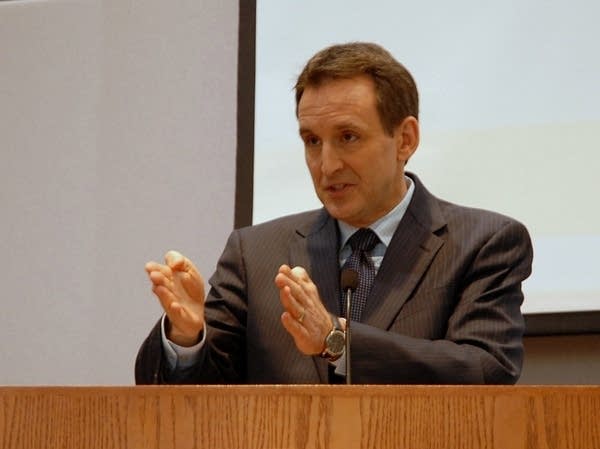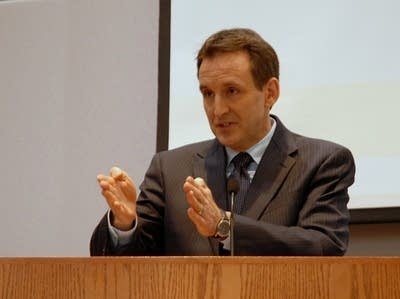Pawlenty's budget: 2.2 percent spending cut
Go Deeper.
Create an account or log in to save stories.
Like this?
Thanks for liking this story! We have added it to a list of your favorite stories.

Despite tough economic times, the Republican governor is also proposing increased spending for public schools and a package of tax breaks for businesses. DFL leaders say they want to work with Pawlenty, but they're concerned about the potential impact of some of his proposed cuts.
Under Governor Pawlenty's $33.6 billion budget, state spending would drop more than 2 percent, or $750 million. The hardest hit spending areas include aid to cities and counties, higher education and health and welfare programs. An estimated 84,000 people would lose eligibility for state-subsidized health care over the next two years, but the governor says his plan would protect eligibility for children. Pawlenty said he built the spending plan based on what he views as state government's priorities.
"We identified those things that we thought were most important to the strategic future of the state of Minnesota and made sure that our commitments to them were either maintained or improved," Pawlenty said. "And then [we] moved down the list into things that we thought were less strategically important or out of alignment or benefited from significant increases in the not too distant past."

Pawlenty is also proposing a package of tax breaks for businesses, including a cut in the corporate tax rate, to try to jumpstart the state economy and grow jobs. His budget preserves funding for veterans programs and public safety and increases spending for K-12 education. While House Democrats are pushing for an overall increase in the state's school funding formula, Pawlenty ties his increase to school districts that raise student achievement.
Turn Up Your Support
MPR News helps you turn down the noise and build shared understanding. Turn up your support for this public resource and keep trusted journalism accessible to all.
"That would be the real miracle in Minnesota, to actually have a system that's accountable, that's transparent and puts kids first and student learning first instead of worrying about the vagaries of a formula that almost nobody can understand," Pawlenty said.
Pawlenty also proposes a wage freeze for all public sector employees. Pawlenty said he does not favor layoffs of state employees as a way to cut costs, saying layoffs would only make the unemployment picture worse.
A bigger help, Pawlenty says, would be to freeze the wages of all public sector workers, including those who work in state and local levels of government, and in public education. That toals about 390,000 people. Pawlenty says freezing teacher salaries, for example, would help school districts cope with budget problems.

"Most school distrcts will tell you that if they could get a wage freeze for their staff and a benefit freeze for their staff, even with a modest increase or no increase, they could still do pretty well in the coming year or two," said Pawlenty. "The thing that drives the spending train for most local units of government, particularly school districts, is staff costs."
The governor's proposal includes relatively small cuts to agencies that oversee the environment and natural resources. The Department of Natural Resources would take a 5 percent reduction in general fund money, or about $5 million.
The DNR says it will look for $2 million in savings in facilities around the state, possibly by closing some offices, and it will charge more for crossing state land for power lines, roads, etc.
Pawlenty decided to make extra investments in forestry, because of the depressed timber economy. The agency's enforcement division will not see cuts.
Conservation advocates and hunting and fishing groups will be watching to see whether the DNR will try to reduce funding for some conservation or habitat programs because of the anticipated income from the new sales tax increase, approved by voters last fall.
DNR Commissioner Mark Holsten said the agency may reduce some grants to local governments, such as for shoreland restoration. But he said those reductions from the general fund could be replaced with money from the Game and Fish fund or the Natural Resources fund -- money that comes from licenses and user fees, not state taxes.
Pawlenty is recommending that the state invest $118 million from the new sales tax revenues for clean water, and $53 million for parks and trails.
In addition to spending cuts, Pawlenty's budget-balancing plan uses more than $1 billion in accounting shifts. He's also counting on at least $920 million in federal aid and he also wants to raise nearly $1 billion from selling half of Minnesota's ongoing tobacco payments.
DFL leaders in the House and Senate have said they want a structurally-balanced budget that avoids one-time money, shifts and gimmicks. House Speaker Margaret Anderson Kelliher of Minneapolis says the governor's plan looks to be full of gimmicks.
"It's not to say that at the end of the day some of those things, they might work in this situation because of how bad it is," Kelliher said. "But it is a concern that if you build a budget completely out of those things, the long term stability of the financial health of the state could be at risk."
Legislative committees begin dissecting the governor's budget proposal this week. DFL leaders also plan to hold meetings throughout the state in the coming weeks to get additional public reaction to the plan.
Senate Majority Leader Larry Pogemiller of Minneapolis was still digesting some of the governor's proposed spending cuts, but he already had concerns about the potential impacts.
"I think we're concerned that perhaps people are being cut off of health care, that's not a smart or necessary thing to do," Pogemiller said. "And we believe that pushing the problem down to local governments to force up property taxes is probably not the wisest thing to do."
Republican legislative leaders had generally positive reviews of the budget plan. House Minority Leader Marty Seifert of Marshall says there aren't a lot of options to solve the deficit.
"If not this, what? That's what our statement is," Seifert said. "If not this, there's little details that we can change around. I'm largely supportive because I think it's a solution that focuses on the priorities of job growth, education and veterans. We have to make some tough decisions here."
The budget debate is just beginning, and Governor Pawlenty said his proposal will need some adjustments in the coming weeks to reflect new financial information.
One change will come when Minnesota learns the amount of its share of the federal economic stimulus bill. Another will come next month, when finance officials update the state economic forecast, which is expected to project an even larger budget deficit.
(MPR reporter Stephanie Hemphill contributed to this report)





